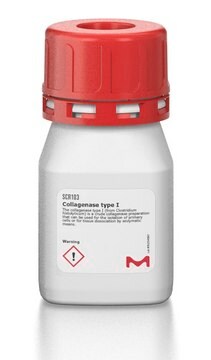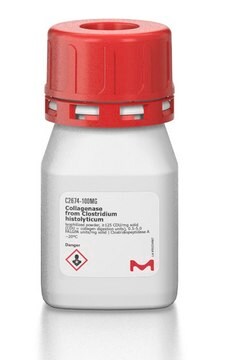C9697
Collagénase from Clostridium histolyticum
lyophilized powder (from 0.2 μm filtered solution), suitable for cell culture
Synonyme(s) :
Clostridiopeptidase A
About This Item
Produits recommandés
Source biologique
Clostridium histolyticum
Niveau de qualité
Stérilité
0.2 μm filtered
Forme
lyophilized powder (from 0.2 μm filtered solution)
Activité spécifique
≥800 units/mg solid
Poids mol.
68-130 kDa
Concentration
1 mg/mL
Technique(s)
cell culture | mammalian: suitable
pH
7.4
Température de stockage
−20°C
Vous recherchez des produits similaires ? Visite Guide de comparaison des produits
Description générale
Application
- Sertoli cell isolation
- Used in the comparison of enzymatic methods
- Tissue preparations for immunocytochemistry
- Testicular sperm extraction
- Preparation of single cell suspensions
- Immunofluorescence
This product is suitable for the disaggregation of human tumor, mouse kidney, human adult and fetal brain, lung and many other epithelia tissues. It has also been shown to be effective in liver and kidney perfusion studies, digestion of pancreas and hepatocyte preparation. Collagenase has also been used in the preparation of arterial tissue for the study of Advanced Glycosylation End Products. This enzyme has been tested for the release of heptatocytes at a concentration of approximately 1mg/mL. Concentrations for digestion range from 0.1 to 5mg/mL.
Actions biochimiques/physiologiques
Attention
Définition de l'unité
Notes préparatoires
Produit(s) apparenté(s)
Mention d'avertissement
Danger
Mentions de danger
Conseils de prudence
Classification des risques
Eye Irrit. 2 - Resp. Sens. 1 - Skin Irrit. 2 - STOT SE 3
Organes cibles
Respiratory system
Code de la classe de stockage
11 - Combustible Solids
Classe de danger pour l'eau (WGK)
WGK 1
Point d'éclair (°F)
Not applicable
Point d'éclair (°C)
Not applicable
Équipement de protection individuelle
dust mask type N95 (US), Eyeshields, Faceshields, Gloves
Certificats d'analyse (COA)
Recherchez un Certificats d'analyse (COA) en saisissant le numéro de lot du produit. Les numéros de lot figurent sur l'étiquette du produit après les mots "Lot" ou "Batch".
Déjà en possession de ce produit ?
Retrouvez la documentation relative aux produits que vous avez récemment achetés dans la Bibliothèque de documents.
Les clients ont également consulté
Notre équipe de scientifiques dispose d'une expérience dans tous les secteurs de la recherche, notamment en sciences de la vie, science des matériaux, synthèse chimique, chromatographie, analyse et dans de nombreux autres domaines..
Contacter notre Service technique






